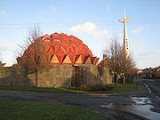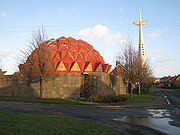
Bowburn
Encyclopedia
Bowburn is a village in County Durham
, England
. It is situated about 3 miles (4.8 km) to the south-east of Durham
, on the A177
, between Coxhoe
to the south-east, and High Shincliffe
to the north-west.
It is part of the Cassop-cum-Quarrington
parish.
. Several coal mines were sunk in the area during the 19th century but extensive development did not begin until an entirely new Bowburn Colliery began to be sunk in 1906. Bowburn therefore celebrated its 100th anniversary on 23 July 2006.
The first “Bowburn Colliery” was a shaft sunk in 1840 but failed to find workable coal.
The second Bowburn Colliery was sunk a few years later, south of there (near Park Hill), being one of several sunk in the Quarrington and Coxhoe areas. It was close to the terminus of the Durham Branch of the Clarence Railway. The pit was a small concern, worked first by Robson and Jackson and then the West Hetton Coal Company. It closed in the 1850s.
The third and most famous Bowburn Colliery was sunk in 1906 by Bell Bros. Ltd., using the 1840 shaft as the ventilation upcast shaft (and, later, for manriding). Its first coal was drawn in 1908. It merged with Tursdale
colliery in 1931 and grew to be one of the largest in the Durham coalfield, working six seams and with about 2950 employees in the 1950s. Meanwhile the village was growing around it. Hardly anything now remains of the colliery complex which closed in July 1967. The colliery yard is now the site of the Bowburn South Industrial Estate.
The day of the annual Durham Miners' Gala
(also called "the Big Meeting") used to see large unions of men marching through the village, as Bowburn was en route to Durham for some surrounding pit village
s. Local residents have recently, with the help of the Heritage Lottery Fund, had two of Bowburn’s original miners’ banners restored and a new one produced to be paraded at the Gala. By September 2006, two of the restored banners were on display in Bowburn Community Centre, together with the new one (the "Centenary Banner"). This, with another new one designed by Bowburn Junior School pupils, was paraded for the first time at the 2006 Gala. Other events also celebrated the village’s centenary year, including a party and firework display in Bowburn Park, exactly 100 years after Gertrude Bell (as daughter of the Chairman of Bell Brothers) cut the first sod on 23 July 1906 to commence the sinking of the downcast shaft.
 Following the closure of the colliery and latterly the Cape Minerals Works, Bowburn declined. More recently the location of the village, near Durham City and close to the A1(M) junction 61, has meant that the village has become a prime site for new commuter housing and industrial estates.
Following the closure of the colliery and latterly the Cape Minerals Works, Bowburn declined. More recently the location of the village, near Durham City and close to the A1(M) junction 61, has meant that the village has become a prime site for new commuter housing and industrial estates.
Much of the housing in Bowburn is still relatively low cost in terraces or on post-war council estates. However there has been significant development of owner occupied housing along the eastern edge of the village, and on the old secondary school site. In recent years, a regeneration project has begun, involving the demolition of some council housing on the northern estate and the building of a mixture of housing association and private housing. As part of the regeneration project, a new park has been built and other improvements to community facilities are expected in the near future.
One of Bowburn's claims to fame was its parish church, Christ the King, built between 1963 and 1978.
It had a detached spire described locally as a 'rocket' standing alongside the main church building, which featured a spiked dome roof which led some to call it "The Pineapple Church". The church ceased to be used used for public worship due to its poor condition and was demolished in June 2007, while the adjacent spire fell over due to gales on 3 October 2009.
In May 2008 construction of a new church building began on the site, completed in Autumn 2008.
Bowburn has its own Junior and Infant & Nursery schools. Secondary pupils attend school outside the village, mostly at Durham Johnston Comprehensive School
in Durham City.
County Durham
County Durham is a ceremonial county and unitary district in north east England. The county town is Durham. The largest settlement in the ceremonial county is the town of Darlington...
, England
England
England is a country that is part of the United Kingdom. It shares land borders with Scotland to the north and Wales to the west; the Irish Sea is to the north west, the Celtic Sea to the south west, with the North Sea to the east and the English Channel to the south separating it from continental...
. It is situated about 3 miles (4.8 km) to the south-east of Durham
Durham
Durham is a city in north east England. It is within the County Durham local government district, and is the county town of the larger ceremonial county...
, on the A177
A177 road
The A177 is a road in County Durham, England. It runs from Stockton to Durham, passing Sedgefield. It therefore links the two main centres for Durham University: Durham City and the university's Queen's Campus in Stockton, via the NetPark knowledge park in Sedgefield, in which the university is a...
, between Coxhoe
Coxhoe
Coxhoe is a village in County Durham, England. It is situated between Bowburn and Cornforth, a few miles south of Durham.Coxhoe is also a civil parish which also includes nearby Quarrington Hill....
to the south-east, and High Shincliffe
High Shincliffe
High Shincliffe is a village in County Durham, England. It is situated about two miles south-east of Durham City, on the A177 road to Stockton-on-Tees...
to the north-west.
It is part of the Cassop-cum-Quarrington
Cassop-cum-Quarrington
Cassop-cum-Quarrington is a civil parish in County Durham, England. According to the 2001 census it had a population of 4,735.The parish covers a number of settlements:* Bowburn* Cassop* Old Cassop* Old Quarrington* Parkhill* Tursdale...
parish.
History
Originally a small farming hamlet, named after the shape of the small burn that runs through it, Bowburn's history, like that of many other villages in the region, is linked closely to coal miningCoal mining
The goal of coal mining is to obtain coal from the ground. Coal is valued for its energy content, and since the 1880s has been widely used to generate electricity. Steel and cement industries use coal as a fuel for extraction of iron from iron ore and for cement production. In the United States,...
. Several coal mines were sunk in the area during the 19th century but extensive development did not begin until an entirely new Bowburn Colliery began to be sunk in 1906. Bowburn therefore celebrated its 100th anniversary on 23 July 2006.
The first “Bowburn Colliery” was a shaft sunk in 1840 but failed to find workable coal.
The second Bowburn Colliery was sunk a few years later, south of there (near Park Hill), being one of several sunk in the Quarrington and Coxhoe areas. It was close to the terminus of the Durham Branch of the Clarence Railway. The pit was a small concern, worked first by Robson and Jackson and then the West Hetton Coal Company. It closed in the 1850s.
The third and most famous Bowburn Colliery was sunk in 1906 by Bell Bros. Ltd., using the 1840 shaft as the ventilation upcast shaft (and, later, for manriding). Its first coal was drawn in 1908. It merged with Tursdale
Tursdale
Tursdale is a hamlet in County Durham, England. It is situated in rural landscape about two miles to the west of Coxhoe, two miles North of Cornforth and around five miles south of Durham. It is part of the civil parish of Cassop-cum-Quarrington.It is ideally located for speedy access to both...
colliery in 1931 and grew to be one of the largest in the Durham coalfield, working six seams and with about 2950 employees in the 1950s. Meanwhile the village was growing around it. Hardly anything now remains of the colliery complex which closed in July 1967. The colliery yard is now the site of the Bowburn South Industrial Estate.
The day of the annual Durham Miners' Gala
Durham Miners' Gala
The Durham Miners' Gala is a large annual gathering held on the second Saturday in July in the city of Durham, England. It is associated with the coal mining heritage of the Durham Coalfield, which stretched throughout the traditional County of Durham. It is also locally called "The Big Meeting"...
(also called "the Big Meeting") used to see large unions of men marching through the village, as Bowburn was en route to Durham for some surrounding pit village
Pit village
A pit village is a term used in the UK for the village serving a deep coal mine.Many of the workers lived in houses that were provided by the colliery. Many villages have experienced depopulation after colliery closures forced people to move to other towns and cities where there are jobs for them...
s. Local residents have recently, with the help of the Heritage Lottery Fund, had two of Bowburn’s original miners’ banners restored and a new one produced to be paraded at the Gala. By September 2006, two of the restored banners were on display in Bowburn Community Centre, together with the new one (the "Centenary Banner"). This, with another new one designed by Bowburn Junior School pupils, was paraded for the first time at the 2006 Gala. Other events also celebrated the village’s centenary year, including a party and firework display in Bowburn Park, exactly 100 years after Gertrude Bell (as daughter of the Chairman of Bell Brothers) cut the first sod on 23 July 1906 to commence the sinking of the downcast shaft.
Facilities

Much of the housing in Bowburn is still relatively low cost in terraces or on post-war council estates. However there has been significant development of owner occupied housing along the eastern edge of the village, and on the old secondary school site. In recent years, a regeneration project has begun, involving the demolition of some council housing on the northern estate and the building of a mixture of housing association and private housing. As part of the regeneration project, a new park has been built and other improvements to community facilities are expected in the near future.
One of Bowburn's claims to fame was its parish church, Christ the King, built between 1963 and 1978.
It had a detached spire described locally as a 'rocket' standing alongside the main church building, which featured a spiked dome roof which led some to call it "The Pineapple Church". The church ceased to be used used for public worship due to its poor condition and was demolished in June 2007, while the adjacent spire fell over due to gales on 3 October 2009.
In May 2008 construction of a new church building began on the site, completed in Autumn 2008.
Bowburn has its own Junior and Infant & Nursery schools. Secondary pupils attend school outside the village, mostly at Durham Johnston Comprehensive School
Durham Johnston Comprehensive School
Durham Johnston Comprehensive School is a secondary school in Durham, UK.IntroductionDurham Johnston is a 1500-place 11-18 school serving Durham City and communities beyond to the south and west. It is situated on Crosssgate Moor, on the A167...
in Durham City.

